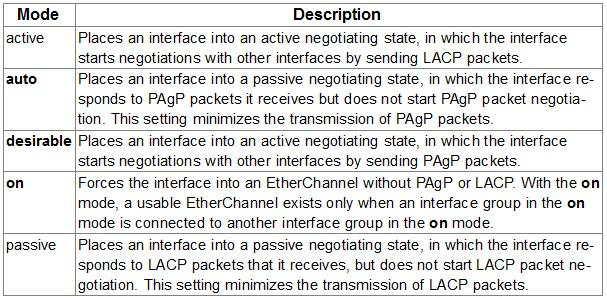
Which set of configurations will result in all ports on both switches successfully bundling into an EtherChannel?
| A. |
switch1: channel-group 1 mode active switch2: channel-group 1 mode auto | |
| B. |
switch1: channel-group 1 mode desirable switch2: channel-group 1 mode passive | |
| C. |
switch1: channel-group 1 mode on switch2: channel-group 1 mode auto | |
| D. |
switch1: channel-group 1 mode desirable switch2: channel-group 1 mode auto |
The different etherchannel modes are described in the table below:

Both the auto and desirable PAgP modes allow interfaces to negotiate with partner interfaces to determine if they can form an EtherChannel based on criteria such as interface speed and, for Layer 2 EtherChannels, trunking state and VLAN numbers.
Interfaces can form an EtherChannel when they are in different PAgP modes as long as the modes are compatible. For example:
* An interface in the desirable mode can form an EtherChannel with another interface that is in the desirable or auto mode.
* An interface in the auto mode can form an EtherChannel with another interface in the desirable mode.
An interface in the auto mode cannot form an EtherChannel with another interface that is also in the auto mode because neither interface starts PAgP negotiation.
An interface in the on mode that is added to a port channel is forced to have the same characteristics as the already existing on mode interfaces in the channel.